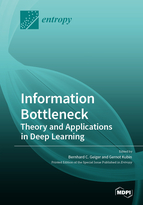Information Bottleneck: Theory and Applications in Deep Learning
A special issue of Entropy (ISSN 1099-4300). This special issue belongs to the section "Information Theory, Probability and Statistics".
Deadline for manuscript submissions: closed (31 July 2020) | Viewed by 51945
Special Issue Editors
2. Signal Processing and Speech Communication Laboratory, Graz University of Technology, 8010 Graz, Austria
Interests: information-theoretic model reduction; information bottleneck theory of deep learning; information-theoretic analysis of machine learning systems; theory-inspired machine learning
Special Issues, Collections and Topics in MDPI journals
Special Issue Information
Dear Colleagues,
The information bottleneck (IB) framework has recently gained popularity in the analysis and design of neural networks (NNs): The “information plane”, quantifying how the latent representations learn what is relevant and “forget” what is irrelevant during training, was shown to allow unprecedented insight into the inner workings of NNs, and the IB functional and its variants have been suggested as cost functions for NN training.
Based on this increased attention, this Special Issue aims to investigate the properties of the IB functional in this new context and to propose new learning mechanisms inspired by the IB framework. In the former aspect, we are interested in both purely theoretical as well as empirical observations that shed new light on the IB framework. In the latter aspect, we solicit papers that discuss training of NNs or other deep, multilayer machine learning models using cost functions that are inspired by the IB principle, even if the cost function itself looks different. Specifically, we seek:
- Manuscripts that provide novel insight into the properties of the IB functional; both purely theoretical and empirical approaches are accepted;
- Manuscripts that apply the IB principle for training deep, i.e., multilayer machine learning structures;
- Manuscripts that discuss cost functions for NN training that are inspired by the IB principle but depart from the IB functional in a well-motivated manner.
Dr. Bernhard C. Geiger
Prof. Dr. Gernot Kubin
Guest Editors
Manuscript Submission Information
Manuscripts should be submitted online at www.mdpi.com by registering and logging in to this website. Once you are registered, click here to go to the submission form. Manuscripts can be submitted until the deadline. All submissions that pass pre-check are peer-reviewed. Accepted papers will be published continuously in the journal (as soon as accepted) and will be listed together on the special issue website. Research articles, review articles as well as short communications are invited. For planned papers, a title and short abstract (about 100 words) can be sent to the Editorial Office for announcement on this website.
Submitted manuscripts should not have been published previously, nor be under consideration for publication elsewhere (except conference proceedings papers). All manuscripts are thoroughly refereed through a single-blind peer-review process. A guide for authors and other relevant information for submission of manuscripts is available on the Instructions for Authors page. Entropy is an international peer-reviewed open access monthly journal published by MDPI.
Please visit the Instructions for Authors page before submitting a manuscript. The Article Processing Charge (APC) for publication in this open access journal is 2600 CHF (Swiss Francs). Submitted papers should be well formatted and use good English. Authors may use MDPI's English editing service prior to publication or during author revisions.
Keywords
- information bottleneck
- neural networks
- multi-layer machine learning models
- learning theory
- information–theoretic cost functions








